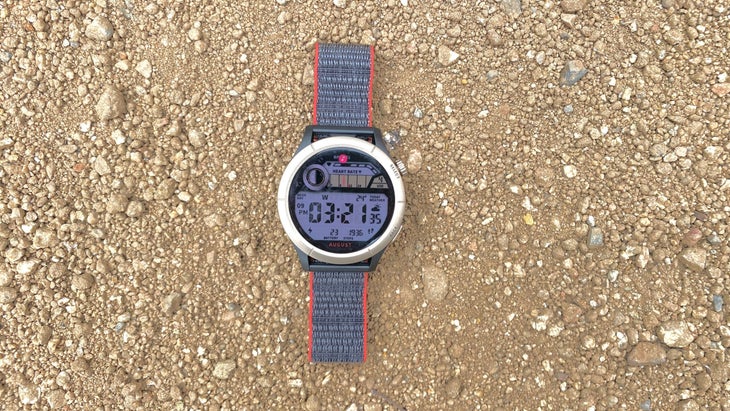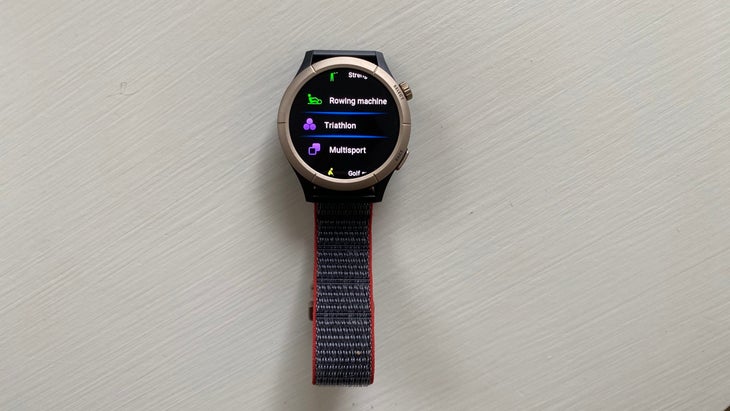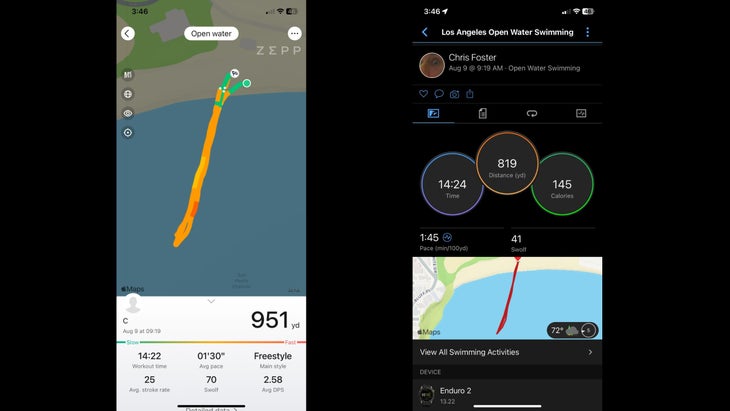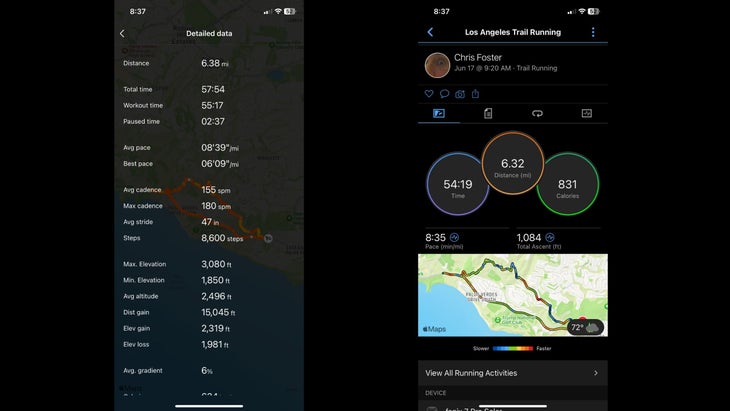The Cheetah Pro ($300) is Amazfit’s best smartwatch yet—boasting a decent battery life, an AMOLED touch display, multi-band GPS, and a full slate of tri features—but it does have issues with usability and accuracy.
Pros
- Better-than-advertised battery life
- Surprisingly excellent and bright AMOLED touchscreen and watch faces
- Crazy amount of features/functions/sport modes
- Decent built-in run coaching
- Light weight
- Competitive price
Cons
- Hit-or-miss GPS/elevation accuracy
- Maybe too many functions
- Inconsistent touchscreen/bevel/buttons performance
- No running with power
- Very limited on-watch post-workout data
Amazfit Cheetah Pro Review
I’ll start this off by saying that this isn’t the first Amazfit watch I’ve tried out. I had a chance to check out one of their previous, super-affordable sport-focused smartwatches, but I didn’t rate it high enough to even warrant a review. It felt so unfinished and beta, I didn’t even know where to begin.
Amazfit is a Chinese brand, established in 2015 with very, very limited presence in North America. Most of their smartwatches are a little more “lifestyle” focused. Think: cheaper Fitbit.
As such, their limited traction in the U.S., coupled with limited interest in endurance sports—especially triathlon, with its open-water swim/tri/multisport features—means it probably isn’t on a lot of athlete’s radars. But with the release of the mostly capable Cheetah Pro, Amazfit is worth another look (with a few caveats, below).
RELATED:��
The Basics

Like many “endurance sports-focused” smartwatches in the $300 price range, the Cheetah Pro ticks the multisport basics—open-water and pool swimming, cycling (though not advanced metrics), running (including only cadence and stride length as advanced metrics), triathlon, and customizable multisport mode (for brick workouts, duathlon, swimrun, etc.). It departs from the typical $300 smartwatch feature list when you get into stuff like the super-bright (and quite pretty) Gorilla glass-covered AMOLED screen, multiband GPS, offline mapping, offline music, a built-in speaker and mic, and a battery life that in our experience exceeds the 14-day published spec. Features like this you usually find in the $450+ smartwatch range.
Granted, not everything is executed perfectly (or even well), but there are so many sports and everyday, “lifestyle” features on this watch—with limited documentation and iffy on-watch navigation—it’s actually difficult to find or use them all. Read on for what works and what doesn’t.
Amazfit Cheetah Pro Review: The Good

As mentioned, there is an absolute embarrassment of riches when it comes to functions, and, while we’ll get into a few that are missing, it’s tough to find something on your smartwatch wishlist that isn’t built into the Cheetah Pro. Tri-important functions like open-water swim, triathlon mode, and multisport mode all work well enough for 95 percent of a triathlete’s needs, and we found each customizable (enough) to present the data fields you want for most training or racing applications.
In terms of hardware, the touchscreen is definitely a pleasant surprise at this price. It’s tough to find a decent AMOLED screen on a sports-capable smartwatch for under $400—the Garmin Forerunner 265 series (which also has a Gorilla Glass AMOLED touchscreen) is probably the closest, and it runs $450. We can confirm that the screen is quite responsive, with minimal ghosting, and the colors are bright and vibrant, even in direct daylight, without completely tanking the battery life. On that note, though Amazfit advertises 14 days of basic use and seven days of heavy use (read: triathlon-level training), we actually found it exceeded these projections by a good amount. We got somewhere between 15–20 days using the always-on display for everyday use, and around 10–15 days with a good slate of workouts thrown in.
The Cheetah Pro also has physiological metrics, like “performance readiness,” recovery, and workout impact—as well as AI run coaching. Further testing could confirm the accuracy of these metrics (maybe), but they were oddly different than our Garmin Enduro 2 control. The important note is that you’ll again get functions usually found on $400+ devices, on a watch that costs far less—and they’re easy to use and understand.
One of the big drawbacks of Amazfit’s previous sports-focused smartwatches was their impossible-to-use user interfaces. The menus were tough to navigate, the settings abstract and not super useful. It’s worth noting that Amazfit has made amazing progress on their UI, and though it’s far from perfect, it’s at least competitive with brands like Suunto, Garmin. Polar, and Coros. The menus make sense, they’re mostly easy to navigate, and they pair well with the AMOLED touchscreen.
Amazfit Cheetah Pro Review: The OK
While the feature list is impressive, and on paper the hardware totally outperforms at this price point, a few lingering issues make the Cheetah Pro a little more “beta” than the finished product you’d see from top competitive brands such as those listed above.
To start, the multi-band GPS is somehow inconsistent when compared with other multi-band GPS smartwatches. On-land distance consistency wasn’t too bad, except in deep canyons, but in the open water we found variances of 10 to 20 percent both relative to the Cheetah Pro (same route, multiple laps, below) and when compared to traditionally excellent open-water smartwatches like the Garmin Enduro 2 or Fenix 7-series. While these variances might not seem like a lot, if you set your lap timer to go off every 500 meters during an open-water interval workout, you could be doing a 400 or you could be doing a 600 from lap to lap. That’s quite a bit.

Elsewhere, but slightly less importantly, we found the elevation gain to differ vastly from high-end smartwatches (below), with very unusual variances in steep terrain. At first, we assumed this was due to a lack of a barometric altimeter (common on smartwatches under $400), but the feature list says the Cheetah Pro is baro-equipped, so the discrepancy is a bit of a mystery.

We also found the performance of both the touchscreen and the buttons (which include a rotating bevel, oddly similar to much of ) to be slightly inconsistent—functioning most of the time, but not always. And after only a few ocean swims (with the recommended fresh water flushing), we had some rough play in the rotating bevel, though it still worked.
Finally, smaller things—like no run power (though it does have somewhat advanced running metrics like stride length and cadence), a very limited on-watch post-workout data screen (forcing you to use the Zepp app, which is actually very good), and intermittent issues with smartphone connectivity—might not be make-or-break for the Cheetah Pro, but it does show that Amazfit isn’t 100% there when it comes to their sport-focused devices.
Conclusions
When compared to the previous Amazfit models that I’ve tried (and hated), the Cheetah Pro might as well be from another brand. Clearly, Amazfit spent some serious time on this smartwatch, spoke to actual athletes, and did some R&D before releasing it into the wild. Also, more than a few menus and UI elements (along with the shape and button style) do look eerily similar to some of Coros’ stuff—if you’re going to “borrow,” you could borrow from worse. Most of the issues we had are pretty small, but some of the hardware problems—like GPS accuracy, elevation gain accuracy, and button/touchscreen inconsistencies show that Amazfit might have ticked the boxes, but still have some ways to go if they’re to compete with Garmin, Suunto, Polar, or Coros—excellent price aside.
Meanwhile, $300 is an absolute bargain for an AMOLED touchscreen smartwatch with a ridiculous amount of sports functions (and a surprising amount of great lifestyle functions that almost no one else is trying in a sports-focused smartwatch, like the speaker and mic).
We obviously only scratched the surface on all of the different features in the Cheetah Pro, but an exhaustive review would end up a tome—especially since the features and functions don’t always work quite as advertised. Bottom line: if you’re looking for a smartwatch under $400 and you need a nice, bright color touchscreen, you literally won’t find anything else that works for tri—but you might need to sacrifice some accuracy in the meantime.


